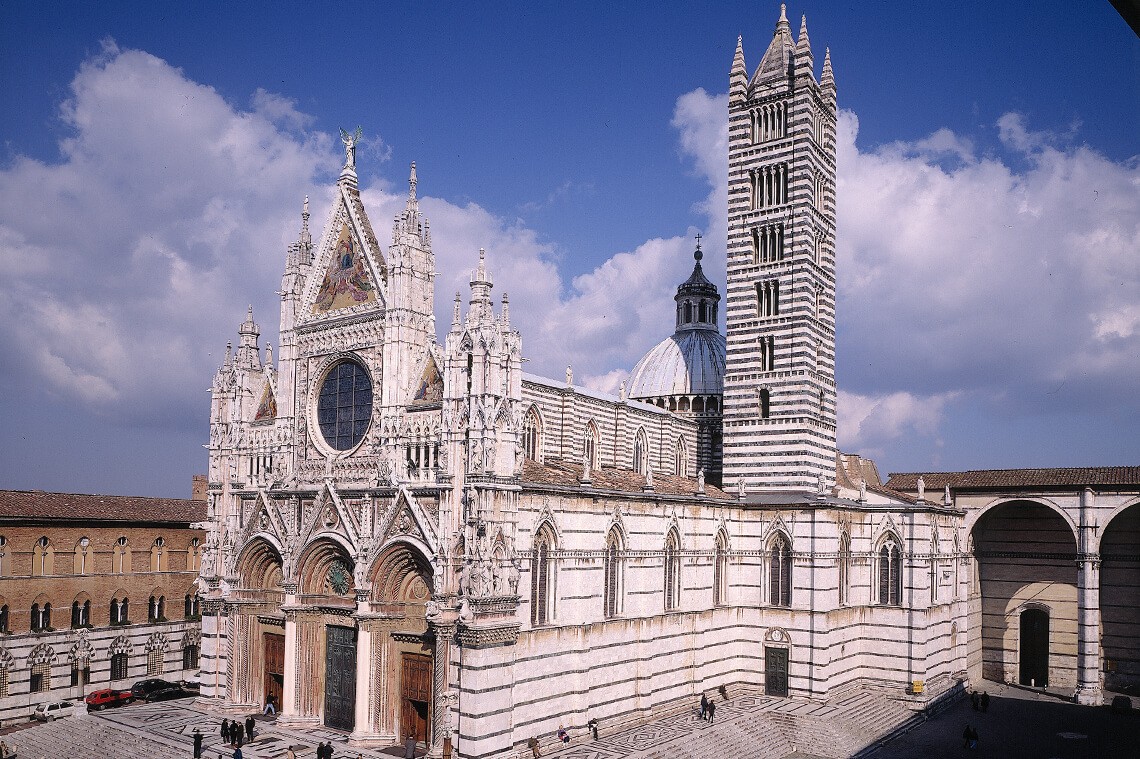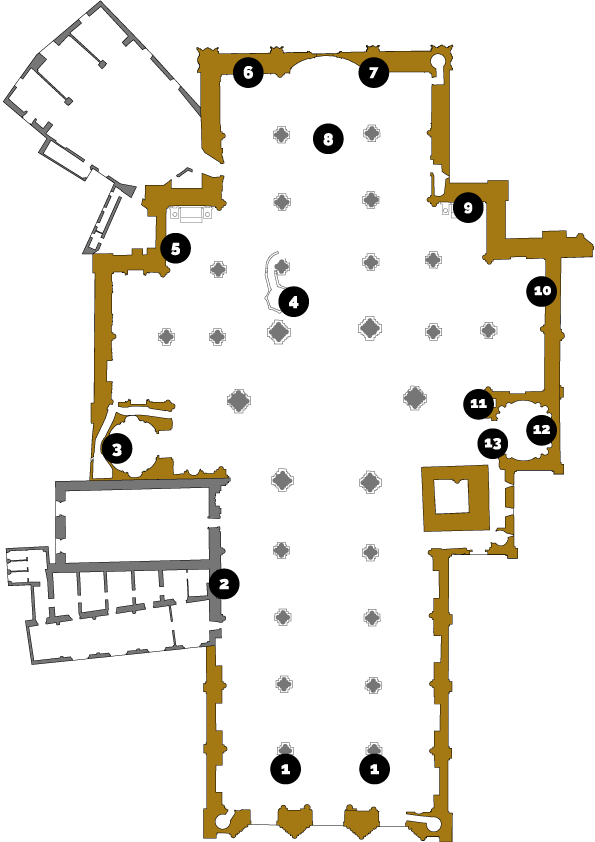
Siena Cathedral, rising majestically in the eponymous city square, is one of Italy’s most illustrious Romanesque and Gothic cathedrals. According to tradition, the present Cathedral replaces an earlier church dedicated to the Virgin Mary erected in the 9th century or thereabouts on the site of a temple serving the cult of Minerva. Equally unconfirmed rumour suggests that the building was consecrated in 1179 in the presence of Sienese Pope Alexander III Bandinelli after the papacy had made peace with the Emperor Frederick Barbarossa. A payment of six soldi recorded as having been made to “Magistro Nichole de Opere Sancte Marie”in April 1259 is likely to be the first mention of Nicola Pisano, one of the 13th century’s most innovative artists who carved the splendid pulpit now in the north transept of the Cathedral. His son Giovanni Pisano, magisterof the Opera from 1284 to 1297, played a key role in the construction of the lower part of the façade and carved the sculptures of prophets, sibyls and philosophers that once adorned it. They were replaced by copies in the course of the 19th and 20th centuries and the originals are now on display in the Museo dell’Opera.
There is a record of a domus being purchased in 1262 to serve as the Opera’s headquarters and as a workshop for the master carvers and stonecutters working on the marble used in the Cathedral’s construction. Lead to cover the dome and copper for the “apple” atop it were bought in in 1263, so the dome must have been completed by that date (though its lantern was rebuilt from scratch, albeit in the original style, in 1667).
The Cathedral contains numerous masterpieces from every age but its marble mosaic inlay and graffito floor is in many ways its most prized possession. Giorgio Vasari certainly considered it the “most beautiful…, largest and most magnificent floor ever made”. The floor we see today is the product of a programme that got under way in the 14th century but was only completed in the 19th century. The preparatory cartoons for the fifty-six inlay panels were supplied by leading artists, all of them Sienese save for the Umbrian painter Bernardino di Betto known as Pinturicchio, who designed the inlay depicting the Mount of Wisdom in 1505. The technique used to transpose the various artists’ ideas onto the floor is known as graffito and mosaic marble inlay.
Sculptures
It is no exaggeration to say that the greatest sculptors of every age have worked for Siena Cathedral. Their number includes Nicola Pisano who carved the pulpitbetween 1265 and 1268, his son Giovanni who carved the sculptures mentioned above for the façade, Donatellowhose surviving work is a statue of St. John the Baptist in the eponymous chapel, Michelangelowho carved St. Peter, St. Paul, St. Pius and St. Augustine for the Piccolomini altar, and Gian Lorenzo Bernini who carved the statues of St. Mary Magdalen and St. Jerome in the “Cappella del Voto” or Chapel of the Vow.
Alongside their work, however, the Cathedral also contains a wealth of sculpture by such artists as Tino di Camaino who carved the tomb of Cardinal Riccardo Petroni, Urbano da Cortona, Antonio Federighi who produced the superb holy-water stoups against the first two piers in the nave and the Holy Saturday Font in the Chapel of St. John the Baptist,Lorenzo di Pietro, known as Vecchietta, who cast the Bronze Tabernacle on Baldassarre Peruzzi’s altar, Giovanni di Stefano, Francesco di Giorgio Martiniwhose contribution to the decoration of the Cathedral consists in two Candle-bearing Angels, Domenico Beccafumiwho cast the eight angels set on pillars flanking the high altar, Giuseppe Mazzuoli, Melchiorre Caffà, Antonio Raggi, and Pietro Balestra who is responsible for the Monumentsdedicated to the popes.
Paintings
Though many of the Cathedral’s panel paintings, canvases and fresco cycles may now be seen in the Museo dell’Opera or in other museums in Italy and abroad, a large number of them are still in situ. Taking them in chronological order, the first one that we should admire is the Madonna del Voto, or Madonna of the Vow, attributed to Dietisalvi di Speme and still in the eponymous chapel today.
The Piccolomini Library is a uniquemasterpiece of the greatest art-historical importance by virtue of its cycle of frescoes painted by Pinturicchioand his workshop between 1503 and 1508 depicting scenes from the life of Pope Pius II set off by a dazzling vault decorated in the “grotesque” style. Showcases around the Library walls contain 15th and 16th century graduals and antiphonaries decorated with delicate and extremely refined illuminations not only by Sienese artists but also by Liberale da Verona and Girolamo da Cremona, both of them famous illustrators summoned to work in Siena in the second half of the 15th century whose style was to have a major impact on local Sienese painting.
The chancel area hosts four large frescoes by Ventura Salimbeni (1610), who was one of the leading lights in Sienese painting at the turn of the 16th century along with his step-brother Francesco Vanni and with Alessandro Casolani. The frescoes depict the Fall of Manna and Esther and Ahasuerus with Sienese Saints on either side.
Last but not least, the Cathedral’s altarpieces are of considerable interest. Little known outside art historical circles, they deserve to attract greater attention inasmuch as they are truly representative of 17th century painting in the broader rather than the strictly local sense, including work by such masters as Carlo Maratta and Mattia Preti.
Stained Glass
The Cathedral’s collection of stained glass is also of the greatest interest. The most important example is Duccio di Boninsegna’s rose window, which once graced the oculus above the apse but has recently been moved to the Museo dell’Opera and been replaced by a copy. The oculus on the façade, on the other hand, contains a stained-glass window depicting the Last Supper made by Guillaume de Marcillat’s pupil Pastorino de’ Pastoriniin 1549. In the bottom centre of the composition we can see, supported by two putti, the crest of Azzolino de’ Cerretani, the rector who commissioned the work, the name of the artist and the date the window was made. The Cathedral also has a set of twelve stained-glass windows in the drum of the dome, made by Ulisse de Matteis in 1886.
Choir
The Cathedral Choir is one of the best-known works in the long and fertile artistic career ofFra Giovanni da Verona (1456–1525), an inlayer and carver who played a leading role in the art world of the 16th century. The thirty-eight inlays were originally made for the abbey of Monte Oliveto Maggiore (1503–5), but Archishop Antonio Felice Zondadari of Siena ordered them to be moved to the Cathedral in 1813 and placed in the two side wings of the early 14th century choir. The artist here has excelled himself in making full use of his remarkable skills as a woodworker to create a series of magnificent objects and symbols of science and theology.
GROUND PLAN OF THE CATHEDRAL
Position of the masterpieces inside the Cathedral:
1 Holy water font – Antonio Federighi
2 St Peter, St Paul, St Gregory, St Augustine. The Piccolomini Altar – Michelangelo
3 Saint John the Baptist – Donatello
4 The pulpit – Nicola Pisano
5 Funerary Monument of Cardinl Petroni – Tino di Camaino
OPENING TIMES THE CATHEDRAL
From 26 December to 7 January 2025
10:00 am – 7:00 pm
Public Holidays: 1:30 am – 5:30 pm
From 8 January to 30 March 2025
10:30 am – 5:30 pm
Public Holidays: 1:30 am – 5:30 pm
From 31 March to 02 november 2025
10:00 am – 7:00 pm
Public Holidays: 1:30 am – 6:00 pm
From 3 November to 24 December 2025
10:30 am – 5:30 pm
Public Holidays: 1:30 am – 5:30 pm
On December 1st, because of the Patron Saint, the Cathedral will be open from 10.30 am to 3.00 pm, with last admission at 2.30 pm. The rest of the complex will be open until 5.00 pm (last admission 4.30 pm).
From 26 December to 6 January 2026
10:00 am – 7:00 pm
Public Holidays: 1:30 am – 5:30 pm
DURING UNCOVERING THE FLOOR
From 27 June to 31 July and from 18 August to 15 October 2025
10:00 am – 7:00 pm
Public Holidays: 09:30 am – 6:00 pm
Last admission 30 minutes before closing time.
The Gate of Heaven ticket can be purchased exclusively online or at the ticket office based on remaining availability.
FULL PRICE
01/01-26/06, 01/08-17/08, 16/10-31/12 2025
€ 5,00
From 27 June to 31 July and from 18 August to 15 October 2025
€ 8,00
REDUCED TICKET(Groups and school groups >14 and groups with a guide)
From 27 June to 31 July and from 18 August to 15 October 2025
€ 6,00
FREE
- Children up to 6 years of age
- Siena municipality residents and born
- Journalists
- Disabled visitors (+ one carer per visitor)
- Clerics of both genders
- Students of University of Siena and University for Foreigners of Siena
- Parish groups of the Archdiocese of Siena with a letter from the parish priest
CALL CENTER
Information, reservations and ticket sales
+39 0577 286300
TICKETS
Immediate access to the masterpieces of the Monumental Complex of the Duomo, reducing waiting times
A SINGLE TICKET THAT ALLOWS ACCESS TO THE CATHEDRAL ROOFS AND TO ALL THE MUSEUMS OF THE COMPLEX
FULL PRICE
01/03 – 06/01: € 21,00
REDUCED TICKET (CHILDREN FROM 7 TO 11 YEARS OF AGE)
01/03 – 06/01: € 6,00
FREE (CHILDREN UP TO 6 YEARS OF AGE)
Remember to always consult the rules of conduct before accessing the tour.
A SINGLE TICKET THAT ALLOWS ACCESS TO ALL THE MUSEUMS OF THE COMPLEX.
Valid for three consecutive days from the date of issue.
FULL PRICE
01/01 – 26/06; 01/08 – 17/08; 16/10 – 31/12: € 14,00
during floor uncovering
(27/06 – 31/07; 18/08 – 15/10): € 16,00
REDUCED TICKET (CHILDREN FROM 7 TO 11 YEARS OF AGE)
01/01 – 31/12: € 3,00
FREE
- Children up to 6 years of age
- Siena municipality residents and born
- Journalists
- Disabled visitors (+ one carer per visitor)
- Clerics of both genders
- Students of University of Siena and University for Foreigners of Siena
- Parish groups of the Archdiocese of Siena with a letter from the parish priest
THE CULT
The Duomo is by definition the house that welcomes the Christian community gathered for liturgical celebrations. Therefore the Cathedral is always accessible to the faithful for prayer through the Door of Forgiveness.
HOLY MASS TIMES
Weekdays: 9:30 am (Chapel of Our Lady of the Vow)
Holidays and days before holidays: 8:00 / 11:00 / 12:15 / 18:00 (Summer 18:30)
In the periods when the floor is uncovered, Holy Masses are celebrated in the church of the Santissima Annunziata:
Weekday: 9:30 am Holidays: 8:00 am – 6:30 pm
For times on the occasion of solemnities or special events see the news section.
* Those born and resident in the Municipality of Siena have free access to the entire monumental complex of the Duomo





